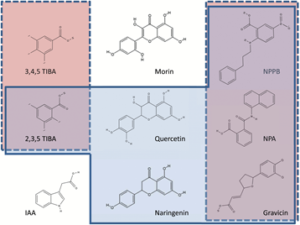Review: Naphthylphthalamic acid and the mechanism of polar auxin transport ($)
 Teale and Palme give an overview of what the last 60 years of using synthetic chemicals inhibitors of polar auxin transport has really taught us. Key among inhibitors is Naphthylphthalamic acid (NPA) that interferes with polar auxin transport and can mimic PIN gene mutant phenotypes. These inhibitors have proven to be invaluable tools and have made it possible to uncover as much as we know today about how auxin is moved, through their complex interactions with the different auxin transporters. Yet questions about auxin transport still remain, including specifics of inhibitor binding, roles of phosphorylation, and whether endogenous plant inhibitors function equivalently. The authors argue that perhaps the clues these inhibitors have and still can provide will lead us to the solutions. (Summary by Aaron Rashotte) J. Exp. Bot. 10.1093/jxb/erx323
Teale and Palme give an overview of what the last 60 years of using synthetic chemicals inhibitors of polar auxin transport has really taught us. Key among inhibitors is Naphthylphthalamic acid (NPA) that interferes with polar auxin transport and can mimic PIN gene mutant phenotypes. These inhibitors have proven to be invaluable tools and have made it possible to uncover as much as we know today about how auxin is moved, through their complex interactions with the different auxin transporters. Yet questions about auxin transport still remain, including specifics of inhibitor binding, roles of phosphorylation, and whether endogenous plant inhibitors function equivalently. The authors argue that perhaps the clues these inhibitors have and still can provide will lead us to the solutions. (Summary by Aaron Rashotte) J. Exp. Bot. 10.1093/jxb/erx323



